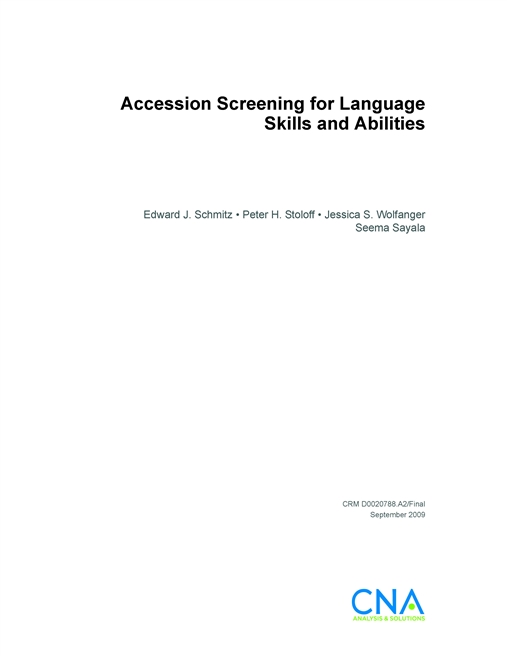Background
Post-9 / 11 military operations have brought to the fore the importance of understanding language and culture for our Nation’s security. As a result, the Department of Defense (DOD) has undertaken substantial efforts to improve its organic capabilities for developing language skills. One important part of DOD’s strategy is to improve its ability to identify military personnel with foreign language capabilities.
Approach
The Defense Language Office asked CNA to investigate DOD’s capabilities to screen for language aptitude. We collected information on the current screening practices of the Army, Air Force, Marine Corps, and Navy. We developed a model of the screening process and investigated the outcomes of each stage—from recruiting through completion of language training. We also collected information on officer language aptitude from the Air Force and the Marine Corps.
Based on our data collection, we estimated models that could be used to identify language aptitude for enlisted and officer accessions. We evaluated attributes—usually available in enlistment records—that could be used to identify the best candidates for language training. We were able to identify several measur es that could be used to predict both officer and enlisted performance in training.
We used our models to evaluate a variety of screening policies. We tested a range of policies to identi fy how different screening strategies could be constructed and evaluated by DOD and each of the services. We compared policies of using the Defense Language Aptitude Battery (DLAB), only using recruit attributes in combination with the DLAB, and replacing the DLAB with readily available recruit attributes.
Findings
As in previous research, we found that the DLAB is a useful indicator for performance at the Defense Language Institute Foreign Language Center (DLIFLC). Other factors that are important in explaining student performance include education and motivation. In addition, we found that aspects about training, including the resources provided and the test used in evaluation, are important to control for in assessing student performance.
We examined the services’ current screening practices and found that all four used the Armed Serv ices Vocational Aptitude Battery (ASVAB) as the single most important factor in identifying candidates for DLAB testing. However, the services differed in their rates of testing; the characteristics of those screened were also different.
We applied our model for predicting DLAB scores to the FY 2008 accession population to see how different approaches to screening could affect the process of identifying recruits for language training. We found that a pre-screening mo del that estimates a candidate’s DLAB score from other information in the enlistment record could greatly improve the efficiency of testing. Also, we considered whether it would be possible to defer DLAB testing for some high-aptitude recruits in order to reduce the burden on pre-enlistment testing.
We also created a model for officer screening. Using information common in most officers’ academic records, we were able to estimate their potential for learning foreign languages. This model could be used for screening officer populatio ns to assess which officers could be trained in a foreign language.
Download reportApprove for Public Release; Distribution Unlimited. Specific authority: N00014-05-D-0500.
Details
- Pages: 100
- Document Number: CRM D0020788.A2/Final
- Publication Date: 9/1/2009
